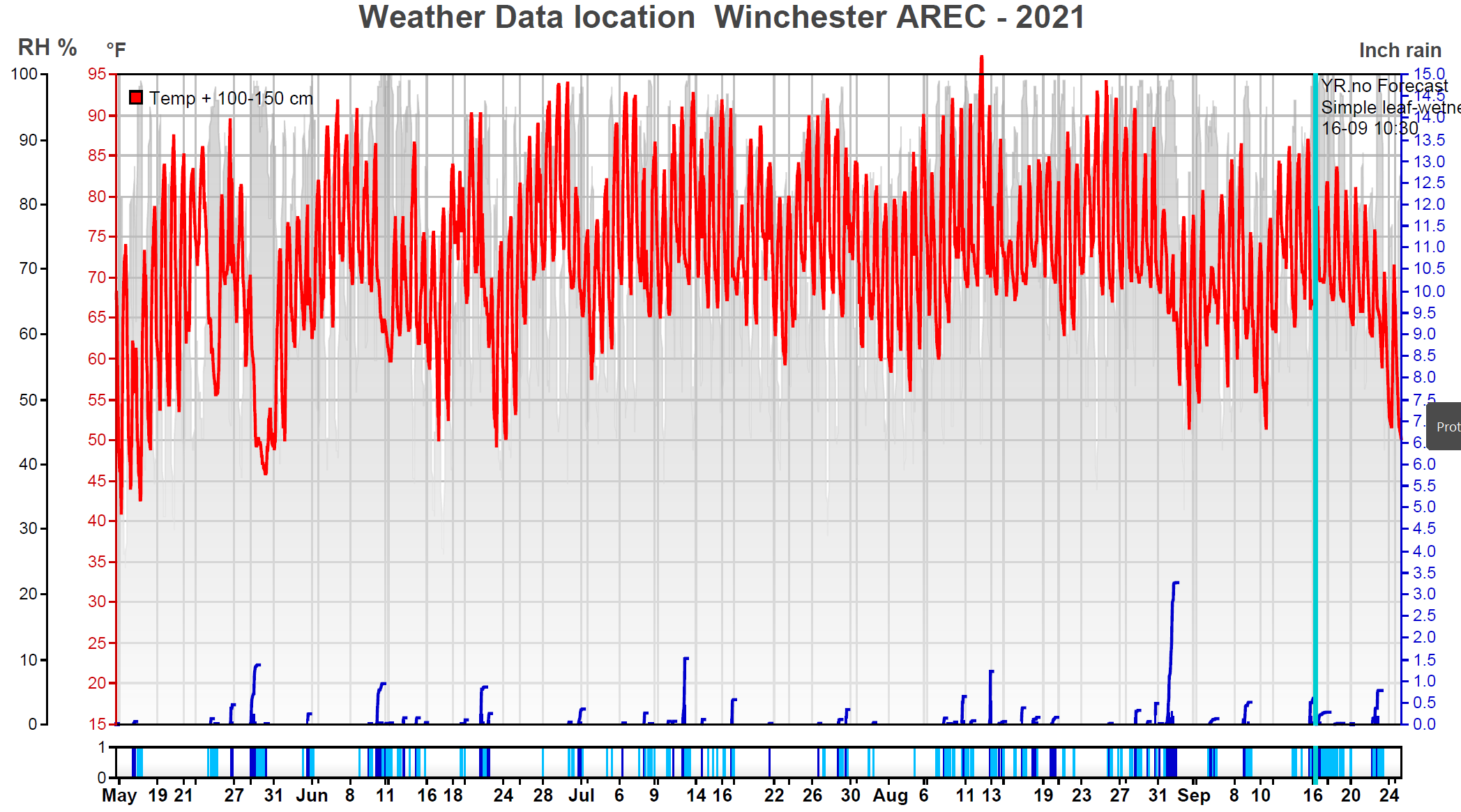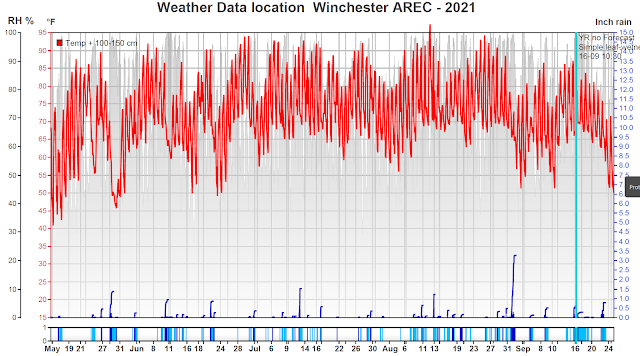More Rain = More Apple Bitter Rot: Late Maturing Apple Cultivars Need Continued Fungicide Protection up Until Harvest (!)

Bitter rot incidence is high in some Virginia and West Virginia apple orchards as hot summer days with drought mid-summer preceded rains in August and September. Bitter rot emerged at an increasing rate where fungicide was stopped in June or July or coverage until harvest was less frequent then necessary after many small rain events that in the end summed up to 2 inches of rain or more (Fig. 1). In addition, we had a severe 3 inches of rain brought in by the hurricane Ida that were highly favorable for infections by bitter rot fungi from genus Colletotrichum. If you spray every row (full orchard coverage), your fungicide cover spray is worth 14 days or 2 inches of rain, whichever comes first. Under this spray scenario, if you do not get rain for 14 days, you can extend the spray interval to 21 days, under the condition that you do not get rain during the 7 additional days. However, if you spray every second row every 14 days (alternate row middle), fruit rots will be or have become an alarming problem in your orchard as not enough fungicide was applied to protect the fruit after rains in August and September increased. Besides juniper rusts that infect apple leaves and fruit in spring, which are the main limiting factor for high yield organic apple production, bitter rot is the second limiting factor making this type of production improbable. With the high heat, abundant rain and high humidity, efficacy of organically approved fungicides is weakened by frequent rains and their overall lower, protective fungicide efficacy. We have timely informed of fruit rot risks with the following blog, before the rains came back and started being more frequent: Protection of Apple Fruit from Bitter Rot from June 25. It is also possible, that in some regions due to flood conditions from Ida, Phytophthora root and collar rot aka Phytophthora root rot (PRR) can become and issue in low lying spots in orchards and require protective sprays with phosphites or Ridomil Gold.
Figure 1. Temperature, humidity and rain amounts and lasting, along with the leaf wetness in 2021, for Winchester VA. Top (central) graph: red line shows temperatures (left y-axis in red), blue curved lines show rain lengths and amounts in inches (right y-axis in blue), grey background represent relative air humidity (RH) in % (far left y-axis in black). Bottom graph with dates shows the length of rain (dark blue) and of wetting periods after the rain stopped or from dew (light blue).
1. Fruit Rots. In more than few commercial orchards bitter rot infections when rampant when spray intervals were stretched at or at more the 14 day interval between cover sprays while at the same time during this interval the singe-event or cumulative rain amount reached 2 or more inches. We received a lot of rain in the last 15 days and are expecting more rain in the next two weeks, therefore, it is essential to continue cover sprays for late maturing cultivars on a schedule where each time when you get a 2 inches or more rain you need to re-cover as soon as you can when middle-rows and leaves dry a bit in the orchard. It is essential to prevent bitter rot infections close to or at harvest on late maturing cultivars that can continue to develop in the pre-storage and storage stages. As we have a lot of late-maturing cultivars such as Cameo, Fuji, Granny Smith and Pink Lady, these cultivars need additional fungicide spray applications during September and/or October, and even November, if they are to be free from bitter rot and if you aim to have 80% and more fruit packout. The continued protective fruit rot sprays are necessary to prevent fruit rot fungi inoculum buildup on and around mechanical wounds where these fungi easily infect the fruit (bird damage, scuffing, branch mechanical injury etc.). These fungicide sprays will prevent inoculum present on already diseased fruit to infect other healthy fruit.
We hope you do not see bitter rot in your orchard and thus indicating that your fungicide coverage was good. However, if by any unfortunate chance bitter rot is on your fruit fruit, especially on highly valuable crop like Granny Smith, our recommendation is to immediately spray the whole orchard with the full rate of captan plus higher rate of Pristine or Merivon other strobiluring containing fungicide (group 11) such as Flint, Luna Sensation or similar. It would be wise to include a surfactant such as LI-700 thus allowing your fungicide to reach better fruit coverage (use only low rate to improve coverage , not penetration!). That should help to inactivate spores on the bitter rot lesions and to protect the remaining healthy fruit from infection until they can be harvested. If fruit will be for Pick-Your-Own, then the full rate of captan close to harvest may be a problem due to overly high residue and a better choice is half-rate of Captan 80 plus a full rate of either Pristine or Merivon (read the labels and PHI limits of these fungicides). After harvest, if you had a lot of bitter rot in the orchard, collect and remove decayed fruit on the ground beneath the trees out, before winter. If this was a block that had fire blight last year or this year, then it is also be very important to cut and remove all of the dead wood because bitter rot can colonize old fire blight strikes and overwinter there. Always check the pesticide label before spray applications as label is the law. Here are the PHI limits for some fungicides used for fruit rots and SB&FS: 0-days for Merivon, Pristine, Double Nickel; up to 1-day for Cueva, Captec 4L; 1-day for Topsin M/Thiophanate Methyl 80WDG, Captan 80/50; 14-days for Flint, Luna Sensation, Ziram, Inspire Super; 30-days for Sovran. If you use captan alone in a single spray application increase the rate to a higher label rate.
2. Phytophthora root and collar rot aka Phytophthora root rot (PRR) occurs on trees in poorly drained sites. It is caused by several Phytophthora species which overwinter in soil. Some of these are common soil inhabitants while the others can be introduced into the orchard on contaminated saplings or root ball soil. When soils are wet for extended periods of time (e.g. floods form Ida hurricane, Fig. 1, Aug 31 to 1 Sep) disease development is favored. Trees exhibit different signs of infection, but some common are reduced tree growth, leaf yellowing , and sudden or slow tree death depending on rootstock/scion combination susceptibility. Late in the season and fall, red or purple leaves often express on affected trees while leaves on healthy trees remain green. Typical root symptoms are red-brown inner bark visible when outer bark is removed. Most severely affected part of the root collar with PRR is usually about 2″ below the soil line. Clear, line separation is visible between red-brown and yellow i.e. healthy part of the rootstock/scion collar. Roots can have similar symptoms visible after tree is removed. Red-brown discoloration separates PRR from other decline tree disorders such as “wet feet” (root drowning) or winter injury. Roots suffering from lack of oxygen due to flood i.e. excessive water are usually completely black and often have an unpleasant scent. Winter injury is mostly confined to the trunk above soil line, especially on the southwest tree side, while below-ground crown may still look healthy. Sending sample to a plant health clinic to confirm PRR is advisable since herbicide injury symptoms could easily be confused with PRR. For herbicide injury the typical symptoms are mild depressions on the spray-facing sides just above the rootstock. If glyphosate was used in the past 4 years, vertical cracks in the bark on the trunk, especially on the north side of the tree are indicative.
To control PRR, apply at least two preventive summer cover sprays with phosphites and captan. This should also help for both Sooty Blotch and Flyspeck (SBFS) and can suppress PRR. There are no effective post infection management options. When it occurs, PRR is as destructive as fire blight and is protected in the wood from fungicides that cannot reach it. A better option to protect other unaffected trees if you had PRR last year or you see it this year is application or Ridomil Gold directed to affected trunk and soil and if few affected trees are found make application immediately. Dwarfing apple rootstock M-9 is somewhat resistant while M-7 and MM-111 are moderately susceptible. M-26, MM-106 and MM-104 are highly susceptible.

